Rental prices have been on an uptrend, swelling to a seven-year high based on Q4 2021 results. While the short-term impact is due to a lack of housing options for permanent residents and foreigners, who form a majority of tenants, there’re also Singaporeans impacted by BTO construction delays or singles wanting a place of their own due to work-from-home complications at their current houses.
Another reason could be due to 2021’s cooling measures, announced on 16 December 2021. With the increased ABSD and Total Debt Servicing Ratio (TDSR) threshold changes, many potential homeowners, such as foreigners and PRs, may have held back buying their homes sooner and opted for renting instead. As demand to rent outstrips available supply, rental prices will naturally go up.
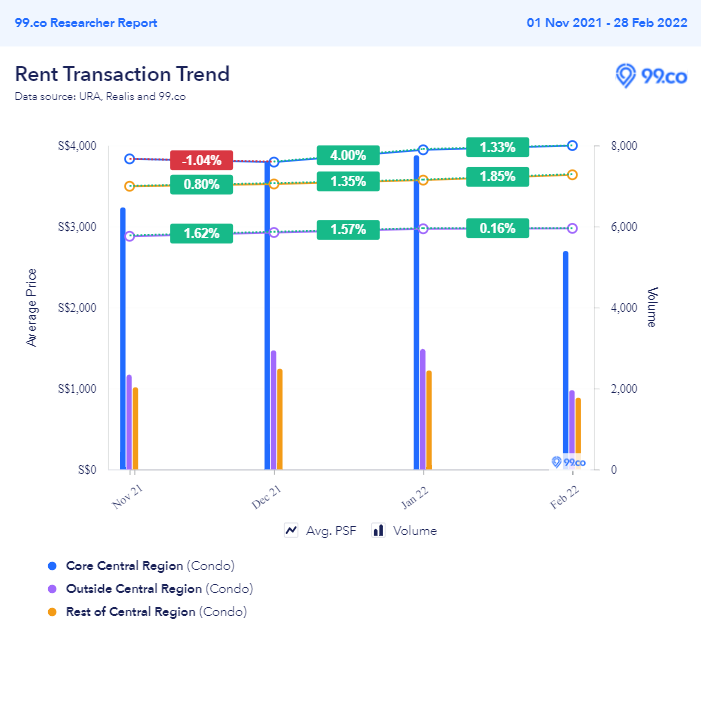
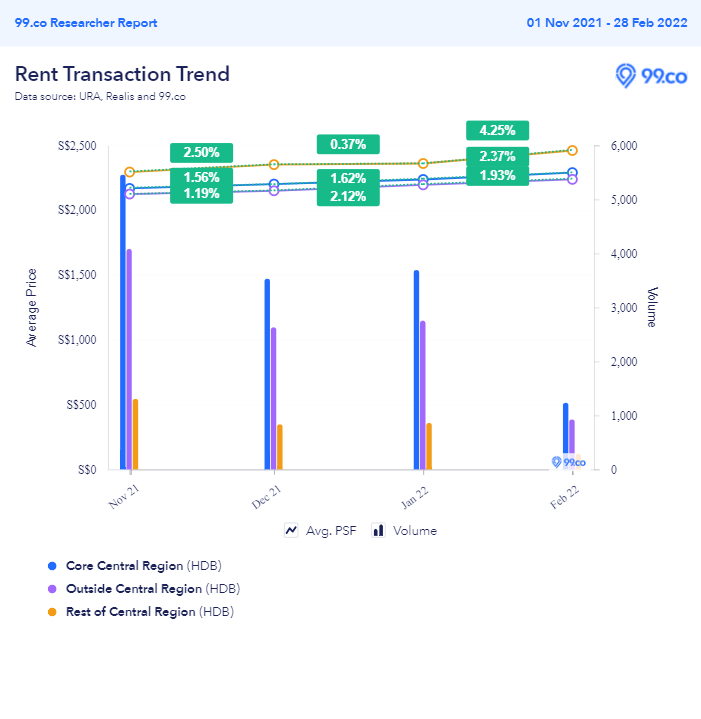
The question on everyone’s minds after seeing these charts: how long will this rental pricing surge last?
While COVID and its variants (and the uncertainty that comes with them) make forecasting difficult, one way to do so is to look at past cooling measures. It may not be indicative of a pattern (as circumstances are different then and now), but it should give us some insight at least.
The “desperate landlord” hypothesis
With the introduction of the 16 December 2021 cooling measure, it is hypothetically possible that existing property investors/landlords may find it much more difficult to “sell” their 2nd or 3rd properties for profit, or at a preferred price within a timeframe they want.
This is because their pool of potential, interested homebuyers may have shrunk or they are taking a slightly longer time to consider – no thanks to the significant increases in Additional Buyers’ Stamp Duty (ABSD) for Singapore PRs and foreigners.
So rather than let their investment property sit idle, it comes to reason that they’ll eventually put them up for rent, or extend existing rental leases, to at least recoup their initial investments, quarterly maintenance fees and taxes. As more landlords compete with one another to attract new or existing tenants, it’s possible we’ll see an increase in rental supply (and price pressure) at some point.
It’s happening in Hong Kong and it’s happened before in some Australian cities like Melbourne and Sydney during the start of the pandemic – basically desperate landlords jostling with one another to win over a tenant.
12 January 2013 Cooling Measure
The January 2013 cooling measure was a major move by MAS where it raised the existing Additional Buyer’s Stamp Duty among Singaporeans, permanent residents and foreigners. It also set new restrictions on the loan-to-value ratio for second and third housing loans and reduced the Mortgage Servicing Ratio for HDB loans from 40% to 35%, and 30% for bank loans.
What this meant is that the pool of ready homebuyers shrunk, leading to investors finding it difficult to sell their 2nd or 3rd properties. Unable to offload their properties, they would then extend their existing rental leases with their tenants for another year or put their investment homes out on the rental market for lease.
Let’s look at how this impacted rental transaction trends across regions during this period, before and after the cooling measure was announced.
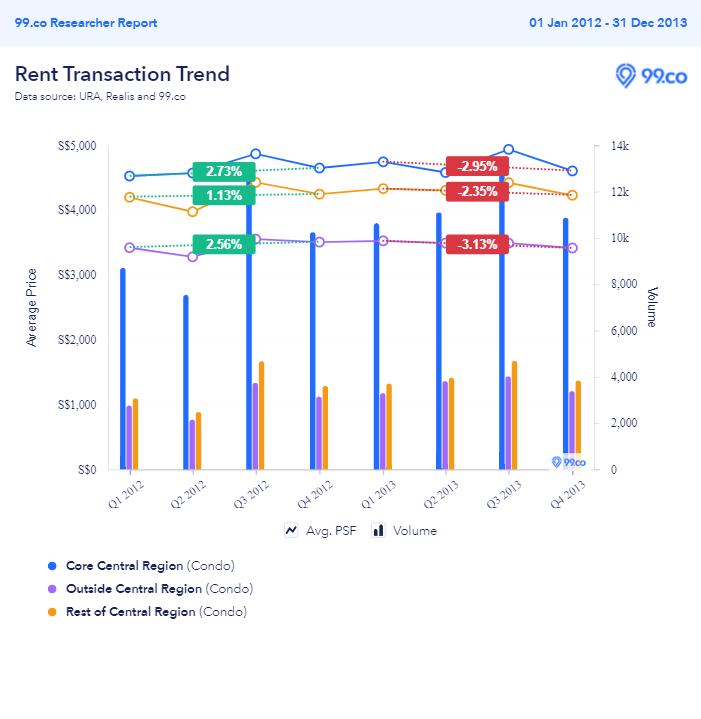
One year before the January 2013 announcement, average rental prices of condos (excluding ECs) were trending upwards at between 1.13 to 2.73% across all three regions. Following the cooling measure announcement in early Q1 2013, the average rental prices of condos dipped between 2.35 and 3.13%.
Year on year, the volume of rental transactions increased by 18% across all three regions, with condos in the OCR seeing a higher percentage at 22.9% from 11,788 to 14,488 transactions. It also saw the biggest year-on-year dip in prices among the three regions at 3.13%.
This meant many investors were renting out their suburban condos during this time and if their apartment was in the vicinity of a cluster of condos (ie. along East Coast), competition may force some of them to lower their prices. Could this be indicative of the “desperate landlord” effect from that January cooling measure?
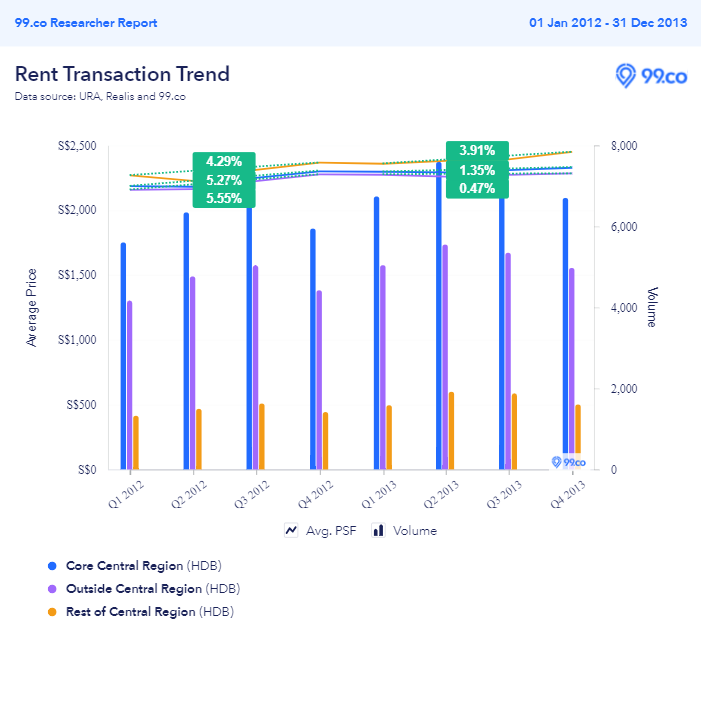
Similarly, for HDB flats, average rental prices were up between 4.29-5.55% during the year prior to the announcement. The highest jump came from Outside Central Region (OCR) at 5.55% with a volume of 18,400. After the announcement, the average rental price increase for OCR was a flat 0.47% despite a higher volume of 21,000 (13.6% increase).
A good insight is HDB average rental prices in the Core Central Region in areas like Tanjong Pagar (eg. Pinnacle at Duxton). This surged by 5.27% the year prior to the announcement, on a volume of 24,689. After the announcement, the average rental price increase in the CCR was lower at 1.35% with a volume of 28,417 (a 13% year-on-year rise).
6 July 2018 Cooling Measure
Let’s look at another more recent cooling measure – which was announced on 5 July and came into effect from 6 July 2018. Here, the ABSD for individuals buying second properties was raised by another 5%, foreigners buying any property had to pay 5% more in ABSD and the loan-to-value limit for bank loans was reduced from 80% to 75%.
Notably, a reduced LTV limit meant homeowners were squeezed on liquidity to afford a new home – so another similar situation (or predicament) for landlords intending to sell their investment homes.
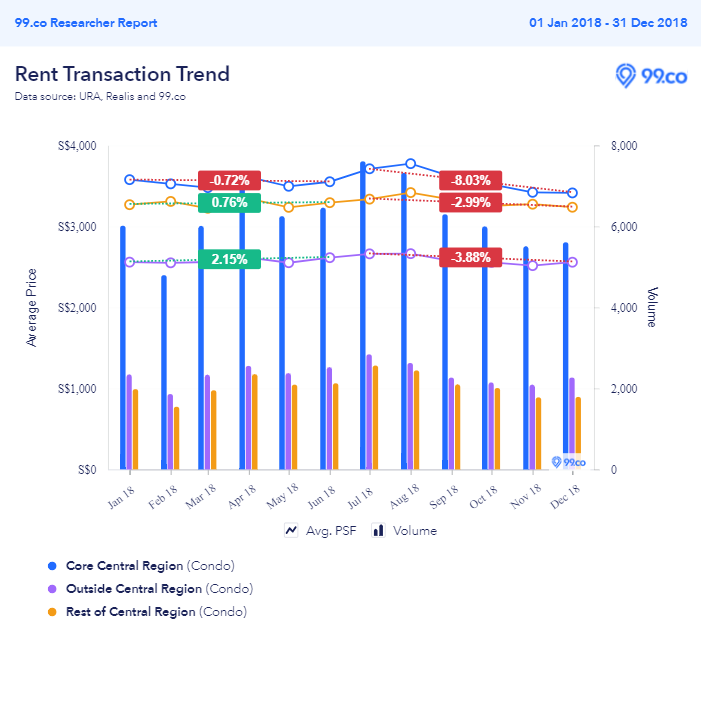
Six months prior to the July 2018 restrictions, changes in average rental prices for condos were positive for OCR and RCR, and fairly flat (-0.72%) for CCR. This changed after the restrictions in July, with average rental prices falling 2.99% (RCR), 3.88% (OCR) and 8.03% (CCR) six months later.
What’s interesting is the volume, which was 62,635 in the first 6 months of 2018. Half a year after the announcement, it went up by 4% to 65,273. Among the three regions, CCR (4.85%) and RCR (5.25%) had higher volume changes. What this possibly means is that post-announcement, there were more rental units transacted across these two regions, causing higher price pressure on vacant rental units in the OCR (contributing to the 3.88% dip in price).
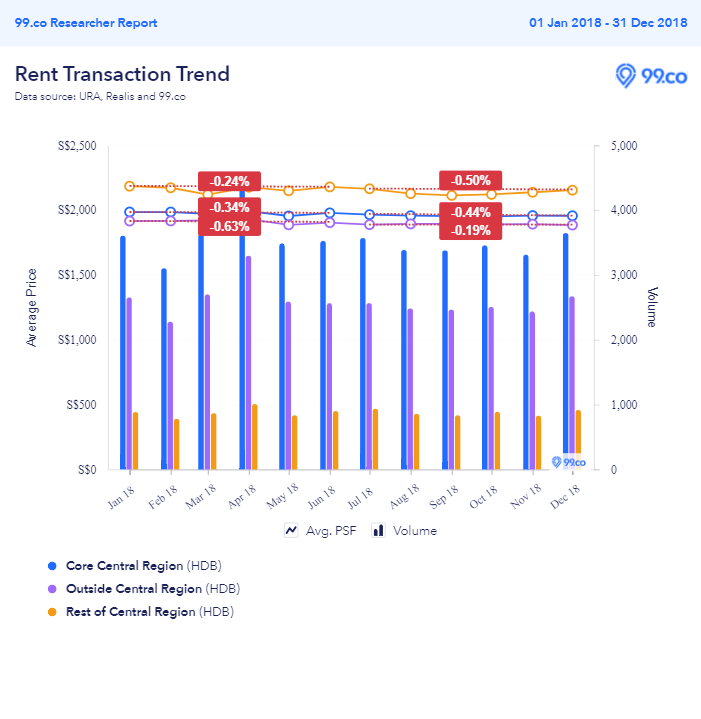
The story’s not quite similar with HDB rentals, where average prices were fairly flat at between -0.24% and -0.63% across regions prior to the restrictions. In the six months after the restrictions, they remained stable, with changes ranging between -0.19% and 0.50%.
The reason is telling, at least if we want to believe the “desperate landlord” hypothesis. In the first six months prior to the restrictions, the volume was 43,092 across all three regions. The following six months saw a 4.54% decline to 41,137. It meant there were lower rental units being transacted after the announcement, which either meant HDB rental demand went down or supply remained flat.
It should be noted that HDB’s public rental flat scheme came into effect in December 2016, which may also have cushioned the demand and supply in this sector.
–
So, despite surging rental rates across both HDB and condo apartments, do you foresee an eventual oversupply and competitive pressure for landlords to lower rent? We’ve seen some trends from two past cooling measure announcements, so could the 16 December 2021 one be any different?
–
When do you think property rental prices will decline? Let us know in the comments section below or on our Facebook post.
If you found this article helpful, check out Rental rates peaking at a six-year high – What are the impact of cooling measures? and Renting in 2022? Here’s how to save on rental rates.
Looking for a property? Find the home of your dreams today on Singapore’s fastest-growing property portal 99.co! If you would like to estimate the potential value of your property, check out 99.co’s Property Value Tool for free. Also, don’t forget to join our Facebook community page! Meanwhile, if you have an interesting property-related story to share with us, drop us a message here — and we’ll review it and get back to you.
The post Will 2021’s cooling measures bring about the “desperate landlord” fall in rental prices? appeared first on 99.co.


